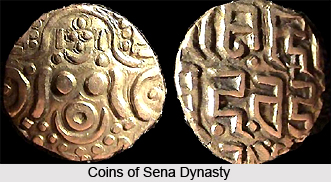 The Sena Dynasty ruled Bengal in the 11th and 12th centuries. Origin of Sena Dynasty, however, is not known clearly. They covered much of the north-eastern region in the Indian Subcontinent. After the Palas they proved to be a major boon to the History of Bengal. The Senas belonged to the Gaur Kayastha sub-caste of the Chitraguptvanshi Kayastha. Hemanta Sen, was the founder of this dynasty who was part of the Pala dynasty till their empire began to weaken. He seized power and styled himself as king. Under the rule of Sena dynasty Bengal also witnessed a major cultural development.
The Sena Dynasty ruled Bengal in the 11th and 12th centuries. Origin of Sena Dynasty, however, is not known clearly. They covered much of the north-eastern region in the Indian Subcontinent. After the Palas they proved to be a major boon to the History of Bengal. The Senas belonged to the Gaur Kayastha sub-caste of the Chitraguptvanshi Kayastha. Hemanta Sen, was the founder of this dynasty who was part of the Pala dynasty till their empire began to weaken. He seized power and styled himself as king. Under the rule of Sena dynasty Bengal also witnessed a major cultural development.
His successor Vijay Sena helped laid the foundations of the Sena dynasty, and reigned for long period. Gaur was captured by Vallalsena from the Pala and became the ruler of Bengal and Delhi as well as made Nabadwip the capital. The reign of Vallalsena was mainly noted for peace and social reform. Vallalsena conquered the territories of Magadha and Mithila and consolidated the kingdoms conquered by his father. He was a patron of art and culture. His reign was marked with cultural resurgenceLakshman Sen succeeded Vallalsena. He expanded the Empire to Assam, Orissa, Bihar and probably to Varanasi also. In the Turkic general Bakhtiyar Khilji attacked Nabadwip, he was unable to conquer Bengal.
The Sena rulers were Hindus due to which Buddhism that had dominated Bengal was in decline. The Sena dynasty built Hindu temples and monasteries including the famous Dhakeshwari Temple which is now in Dhaka, Bangladesh. They were also great patrons of literature. Bengali Literature witnessed a major growth during the rule of Sena dynasty. Some Bengali authors believe that Jayadeva, the famous Sanskrit poet and author of Gita Govinda, was one of the Pancharatnas in the court of Lakshman Sen.
Vishwarupa Sena and Kesava Sena were successors of Lakshmana Sena who ruled for more than a half century. Vishwarupa, son of Lakshmana Sena ruled Eastern Bengal. He successfully repulsed invasion of Eastern Bengal by the Muslims. His brother Kesava Sena carried on the legacy. He is the last known ruler of Sena dynasty.
After the Sena dynasty, the Deva dynasty ruled in eastern part of Bengal. The Sena rule constitutes an important landmark in the history of Bengal. The Sena period saw a great development in Sanskrit literature also. Brahmanical Hinduism revived in Bengal during this period.






